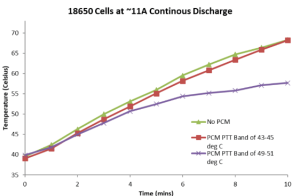Cooling the Heat: Why Phase Transition Temperature of PCM Matters in Battery Thermal Management
Passive thermal management of battery packs is one of the key challenges faced by the electric vehicle industry. In India, where the ambient temperatures can soar up to 45°C, finding a solution that efficiently manages the heat generated by the battery pack is of utmost importance. This is where Phase Change Materials (PCMs) come into play. PCMs are materials that can store large amounts of thermal energy during phase transitions, thereby maintaining the temperature of the battery pack within a safe operating range.
However, choosing the correct phase transition temperature for a PCM is crucial for effective thermal management of battery packs.
Band of concern
In India, at many places and on many days, the maximum temperature in summer can go beyond 400C, while the minimum temperature in winters can go below 100C, with average temperatures between 190 and 330 C. Since our focus is to prevent cell degradation and loss of cycle life due to higher operating temperatures, our temperature band of concern should start at a few degrees above 330C, say 380C. For passive thermal management, any heat within the pack can only go out if the pack temperature is more than the ambient. Since we have ambient temperatures going beyond 400C., the lower point of the band of concern needs to be moved a few degrees higher than 400C, say 450C.
To verify and confirm this, LHS tested 18650 cells under different conditions such as cells with no PCM, with PCM having phase transition band of 43-450C and phase transition of 49-510C, where the cells were charged to 100% SOC and discharged at 11A. Too low in transition temperature could result in a PCM that is saturated before use as seen in the graph below. The 43-450C PCM is already close to saturation before testing begins and is quickly melted during first stage of test. Compare this to the 49-510C PCM which has full energy capacity available during the test.

At the higher end, cell manufacturers typically ask customers to ensure that the temperature never goes beyond 600C, our band of concern should end a few degrees below 600C, say 550C.
Thus, the band of concern is roughly 450C to 550C.
F&F-91 – the ideal band
While the band of concern starts at 450C, we don’t want to get too close to it for effective dissipation on days with really high temperatures. Similarly, we want to keep the cells safely away from the high end, i.e. 550C.
F&F-91 from Latent Heat Solutions LLC provides ideal transition temperature band of 490C to 510C within which it will absorb more than 200 KJ / KG, to ensure that the cycle life is optimum and prevent degradation as well as maintain a more uniform pack temperature.
For more such information, you can contact us/visit:




